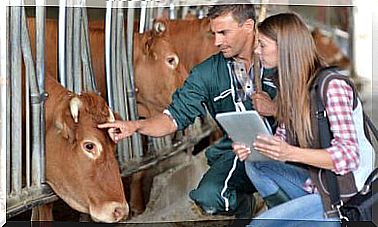Distemper: What Is It And How To Treat It In Dogs And Cats?

Distemper is a viral disease that can affect several dogs, cats and ferrets. As a pet tutor, it is very important to be aware of the need for vaccinations to prevent this type of disease. Especially puppies and older dogs are the animals most susceptible to contracting this disease.
In dogs, distemper is very serious and can be fatal in ferrets. Prevention of this disease is so important that it is among the first vaccines that the vet gives when you go to the clinic with your pet.
What Causes Distemper in Dogs and Cats?
This disease is caused by the canine distemper virus, which is part of the measles virus family in humans. Transmission occurs through contact with infected material, body fluids of infected animals, or through the air.
This virus is found in nasal secretions and tears that spread as droplets in the air, similar to the flu in humans. Infected dogs can spread the virus for several months.
It spreads very quickly among dogs in kennels and places where many animals can flock, such as parks. The incubation period is 14-18 days and depending on the strain, it can be more or less virulent, with different prognosis, symptoms and evolution.

What are the symptoms of distemper in dogs and cats?
Depending on the immune status of the animal, symptoms can manifest themselves in the first days or appear when the evolution of the disease is more serious. The organs where the virus affects are the epithelium and the nervous system. For this reason, it can cause a wide variety of different symptoms:
- Fever. It can often exceed 39 degrees.
- Diarrhea with bleeding.
- He retched.
- Dehydration.
- Apathy and loss of appetite.
- Cough and difficulty breathing or wheezing. There may be secondary Bordetella infections that cause pneumonia in the animal.
- Excess of nasal secretions. The consistency is liquid at first, but can become mucopurulent.
- Conjunctivitis.
- Ataxia. It is possible to understand whether the virus has affected the brain with the appearance of uncontrolled contractions in different muscles of the body.
- Convulsions.
- Encephalitis. Brain irritation and inflammation.
The picture is very broad and can include many other ailments. A not very worrying symptom, but characteristic of distemper, is the hyperkeratosis of the pads, that is an atypical thickening of the fingertips of the paws. Neurological symptoms can sometimes appear weeks or months after an initial recovery.
Prevention is the best weapon
At around six weeks of age in dogs and eight weeks in cats, a vaccination against distemper is highly recommended. This vaccine also contains protection against other diseases, such as parvo. Several doses of revaccination are required for the animal to acquire immunity, as well as an annual booster dose for life.
Unvaccinated animals can lose their immunity and become infected during times of stress or immunosuppression. They can be exposed to both distemper and other diseases that require booster doses.
Puppies acquire their first immunity to distemper through their mother’s milk colostrum, which can last for up to eight weeks. Bottle-fed kittens or cats have immunity for approximately the first 4 weeks of life.
Are there any treatments to cure distemper?
Distemper is diagnosed both by the symptoms present in the animal and by a blood test. The mortality rate is estimated to be around 50% – 90%, depending on the virulence of the strain.
There is no specific treatment. However, the vet will provide fluid therapy support and symptomatic therapy, as well as prescribing antibiotics to avoid secondary infections. Daily washing of secretions in the eyes and nose is also advisable.
If the vet confirms the diagnosis of distemper, it is essential to keep the animal under control in the clinic and most likely will have to be hospitalized until its stabilization. Once the disease is under control, it is necessary to be constant and have regular veterinary visits.
If you have multiple pets, you should isolate the sick animal, increase hygiene measures, and wash clothes and hands before touching other pets. If the animal recovers from the distemper but its nervous system has been affected, there can be permanent consequences. In this case, the animal may have sporadic episodes of convulsions or ataxia.

Distemper, like other common dog diseases, can be easily prevented by adhering to the vaccination schedule recommended by your vet. With vaccines, we practically reduce the chances of our beloved pet contracting serious diseases like this to almost zero.









